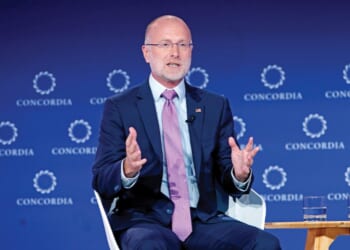HHS Secretary Robert F. Kennedy Jr. sent shockwaves through the public health community Tuesday when he announced that the Biomedical Advanced Research and Development Authority will cancel 22 projects related to mRNA vaccine development for COVID-19, influenza, and other upper respiratory viruses.
However, scientists, public health experts, and politicians have said the divestment will slow or disincentivize pharmaceutical companies from continuing to develop promising mRNA technologies for cancer immunotherapies.
These novel treatments have shown great promise in recent years against some of the most aggressive and deadly cancers, including pancreatic cancer, lung cancer, breast cancer, colorectal cancer, and even the brain cancer glioblastoma.
On Wednesday, Hillary Clinton lambasted Kennedy and President Donald Trump on X, saying, “In the war against deadly diseases like COVID and cancer, the Trump administration has chosen the side of COVID and cancer.”
Although the long-term effects of canceling the mRNA research projects under BARDA’s purview will be borne out over time, it’s unclear right now what the changes will mean for the future of cancer treatment.
Here’s what we do know.
How mRNA cancer treatment works
First discovered in the 1960s, mRNA, or messenger RNA, is a naturally occurring nucleic acid compound that essentially provides the instructions for all cells to make proteins. It’s one of the building blocks of life for complex cellular organisms.
In the case of mRNA-based cancer vaccines, these immunotherapies essentially use the mechanics of this natural process to teach the patient’s immune system to recognize and attack cancer cells.
After the vaccine is administered, the mRNA genetic instructions are absorbed by nearby immune cells called dendritic cells, or DCs. DCs pick up the mRNA and start making proteins based on the instructions received from the injected mRNA.
Specifically, they start making the antigen protein found on the surface of the cancer cells that comprise the patient’s tumor.
Once the antigens are made, the DCs present them on their outside surface to attract T-cells, known as the immune system’s “killers.” The T-cells then identify the antigen and hunt for the actual cancer cells in the body that have the same antigen on their surface.
mRNA virus-targeting vaccines different from cancer therapeutics
Although the COVID-19 mRNA vaccines use a similar process of training the immune system, they have key differences from mRNA-based cancer vaccines.
Part of what makes mRNA-based cancer therapeutics effective is that they can be formulated using the exact antigens found on a patient’s tumor cells. In other words, mRNA-based cancer vaccines are uniquely designed for the patient.
This is different from the process for mRNA COVID-19 or influenza vaccines that train cells to recognize the surface proteins of particular viruses, which is scientifically termed a “universal antigen.”
mRNA viral vaccines are a “one-size-fits-all” approach compared to the highly personalized use of mRNA technology for cancer patients.
A key component of the political backlash against COVID-19 vaccines during the pandemic was the mass vaccination campaign and strict mandates for an “experimental vaccine.”
Kennedy has engaged in anti-vaccine rhetoric, including the debunked claim that vaccines cause autism and cancer. He even said in 2021 that the COVID-19 vaccines were “the most deadly” vaccine in history.
However, Kennedy hasn’t specifically said anything about using mRNA technology for cancer immunotherapeutics.
Cancer concerns dismissed by HHS
Although Tuesday’s announcement does not directly affect cancer research, scientists in the field have expressed significant concerns that cuts are harbingers of more changes to mRNA research on the horizon.
In March, anonymous sources in the National Institutes of Health told KFF Health News that officials were urging scientists to remove all references to mRNA vaccine technology from their grant applications out of fear that grants would not be accepted or would later be targeted for cancellation.
When asked about the possible implications for cancer research, HHS spokesman Andrew Nixon told the Washington Examiner that “the announcement was very clear” in that only mRNA research for upper respiratory infections will be terminated.
“Other mRNA technology investments in the Department are not affected,” said Nixon, reiterating the point from the original press release.
Nixon did not respond to the Washington Examiner‘s multiple questions regarding what other mRNA projects for cancer research are currently being funded by the department.
Other countries will likely fill in the funding gaps
Even if the government divests from more mRNA research projects, such as those for cancer immunotherapies, advancements in mRNA cancer vaccines could still be developed with international funding, particularly from Europe and China.
Sen. Bill Cassidy (R-LA), who has publicly opposed Kennedy’s vaccine stance on multiple occasions, posted on X that BARDA’s move undermines U.S. security interests because it gives China an advantage in pioneering revolutions in mRNA technology.
Cassidy said it was “unfortunate” that Kennedy’s cancellation wasted already spent taxpayer investment and added that he “has also conceded to China an important technology needed to combat cancer and infectious disease.”
According to the China National Center for Biotechnology Development, Chinese mRNA research funding has surged by more than 30% since 2024. The mRNA vaccine market in China is anticipated to reach $2.5 billion by the end of 2025.
THE RACE FOR A LYME DISEASE VACCINE
So far, much of China’s mRNA technology investment appears to be related to viruses and pandemic prevention, and the implications for cancer research are unclear.
In Europe, the mRNA therapeutics market was estimated in an April analysis to reach $8.7 billion by 2030, growing by 14.6% compounded annually between 2024 and 2030.















